
Bunion Specialist in High Wycombe, Buckinghamshire, Elstree
A bunion is a bony protuberance on the outer surface or at the base of the big toe. The major causes of bunions are heredity and wearing of ill-fitting shoes. The condition often results in swelling, pain around the big toe and discomfort while walking due to restricted movements of the big toe. Precision Foot and Ankle, Orthopaedic Surgeon, Mr. Kinner Davda provides expert diagnosis and individualised non-operative and operative treatments for bunions in High Wycombe, Buckinghamshire and Elstree. Contact Precision Foot and Ankle, Orthopaedic Surgeon, Mr Kinner Davda or his team at any of these locations for an appointment today!
- Request an Appointment
- Secretary
- HCA Esltree
- BMI Shelburne
- BMI Chiltern
What is a bunion?
A bunion is a common term for hallux valgus. In this condition, the big toe drifts outwards towards the lesser toes, and a bump appears along the inner border of the foot in the region of the big toe joint. The bump is not usually due to extra bone formation, but due to the bone of the big toe becoming more prominent.
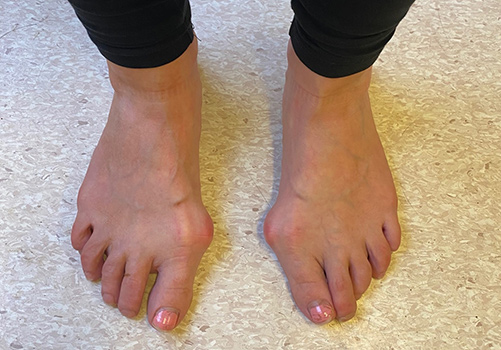
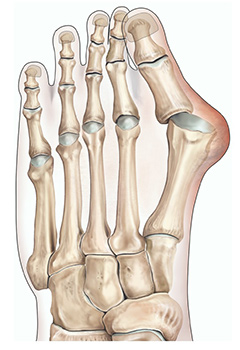
The above pictures show the typical appearance of bunions, affecting both feet in this case. This is further illustrated by the diagram which shows deviation of the big toe.
How is it caused?
There are several theories. It is common for bunion problems to run in families. Wearing inappropriate shoes, supple or hypermobile joints and flat feet have also been associated as factors.
What are the symptoms?
Most people do not suffer any symptoms, but some will develop pain over the bunion, difficulty with wearing shoes, and in severe cases, pain when walking.
Assessment
Your symptoms and a medical examination will determine the type of treatment that will be most appropriate for you. Conditions such as rheumatoid arthritis and diabetes may be present and affect the method of treatment your surgeon provides.
What treatment is available?
Non-surgical
Bunions can be treated without the need for surgery, depending on the severity and symptoms. Simple measures include the use of bunion toe spacers and straps. Pads made of silicone and other materials can be used to cushion prominent and tender areas. Wider and larger shoes may alleviate the pressure caused by the bunion. Hard skin that develops under the big toe or lesser toes can be smoothed down by lotions, a pumice stone or by regular visits to a chiropodist.
Surgical
If conservative measures fail to improve symptoms, an operation can be considered. In some bunions, achieving a completely straight big toe is undesirable, as it leaves a large gap between the first and second toe, and appears unnatural. Hence, the aim of a bunion correction operation is to improve the alignment of the big toe.
Before surgery
Your fitness for surgery and your foot symptoms will be reassessed in our pre-assessment clinic, which usually takes place prior to the date of operation. Blood tests and further investigations of the heart and lungs may be required to ensure you are fit to have a general anaesthetic. If you live alone, we will liaise with your GP and social services to ensure that care is in place to look after you following surgery. Occasionally, you may need to spend a few extra days in hospital whilst the services are being organised.
We kindly ask that you contact us if you suffer an insect bite, cut or bruise to the symptomatic foot in the period leading up to your surgery. Any injury to the skin in the area of your intended surgery can increase the risk of infection. You may need reassessment and surgery reorganised for another time.
On the day of surgery
You will be seen before surgery by Mr. Davda or a member of the team to check your consent and mark the leg. Forefoot surgery is typically performed under general anaesthetic, which can be discussed with your anaesthetist.
In most cases of hallux valgus surgery, you will be able to go home the same day. Sometimes, it is necessary to spend a night in the hospital depending on your general health and immediate recovery from the operation. Local anaesthetic is also applied at the time of surgery to provide pain relief and numb the foot. This can last for up to a day after.
The operation
An incision is made along the inner border of the foot over the bunion. The soft tissues around the big toe joint such as ligaments and muscle are released between the first and second toe. The big toe ‘metatarsal’ bone is then cut, known as an ‘osteotomy’, and realigned. It is fixed using small screws, which are buried in the bone and do not usually need to be removed. A further step is sometimes required to achieve final correction. A small wedge of bone from the smaller bone of the big toe (known as the proximal phalanx) may also need to be removed and fixed with either a staple or screw. Finally, the soft tissue around the big toe is firmly repaired. The skin is sutured with dissolving stitches. The foot and ankle will be dressed wrapped in a ‘bunion’ bandage which stays on for six weeks following surgery.
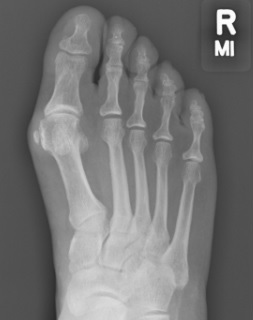
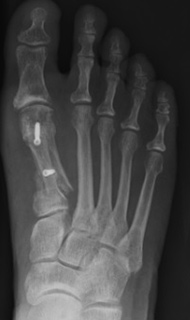
The figures above show the typical x-ray appearances of a bunion before and after correction. The first metatarsal bone has been cut, realigned and fixed with two screws using a ‘Scarf’ technique. In some cases, a further correction may need to be made by removing a small wedge from the big toe bone, which is secured with a small staple. This is known as an ‘Akin’ cut.
Surgery will take about an hour, more if further work is required to address lesser toe deformities. The whole process of taking you to the operating theatre, having surgery and recovering from anaesthetic thereafter will take about half a day.
After The Operation
It is not uncommon for the wound to bleed a little and stain the bandaging, particularly when standing for the first time after the operation. You will be provided a special shoe which helps to off load weight from the forefoot. The physiotherapist will give you instructions on how to wear the shoe and in the use of elbow crutches if required.
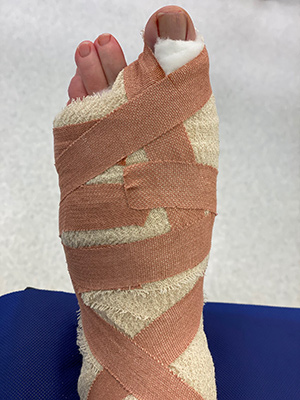
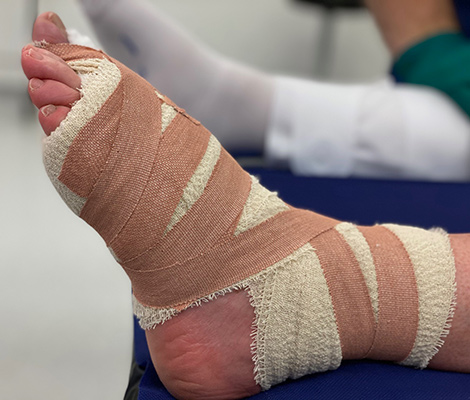
The above photos demonstrate the typical bandaging that is used to protect the bunion correction. This will be removed at 2 weeks and replaced with a fresh bandage.
For the first two weeks following surgery, you are advised to elevate the foot on 2-3 pillows as much as possible, and limit the amount you walk to as little as practically possible. This will help reduce the swelling in the foot and promote healing of the wound.
At about two weeks, you will be seen in our post-operative clinic when the wound is checked and the bunion bandage reapplied. These dressings will be removed completely and a check x-ray taken at your next appointment at about 6 weeks following surgery.
Common Questions
When can I drive?
Patients having had their left foot operated on will be able to drive an automatic car within two weeks. Those who have had an operation on the right side will be able to drive after about 6 weeks. You are advised to contact your insurance company to ensure you are covered to drive.
When can I fly?
You are advised not to fly until you have been seen for a check x-ray. This is about 6 weeks following surgery.
When can I go back to work?
This will depend on the type of work you do. For example, if you have a desk job you may be able to return to work after two weeks provided you are able to rest and elevate your foot whilst sitting. If you do a physically demanding job, you may need 8-10 weeks off.
When can I return to sport?
You can usually return to sports between three and six months from the date of surgery. Recreational walking or light sporting activity may be resumed earlier.
General Complications of Surgery
Modern forefoot surgery has a success rate of over 90% but, as with all surgery, complications can occur. You should not contemplate surgery for cosmetic reasons only.
Swelling
This is very common after surgery. It is a side effect, rather than a complication, and can take up to a year to recover. You may need a shoe size slightly larger than you normally wear during this period.
Infection
This can occur in a small percentage of patients. If this is the case, it is possible that further surgery may be required to remove infected bone or screws. Minor infections are commoner and normally settle after a short course of antibiotics.
Numbness and tingling
This occurs at the surgical site, as a result of minor nerve damage and usually recovers over the course of six months.
Stiffness
This can occur in the big toe joint. I would encourage you to gently move the big toe up and down after surgery at periodic intervals.
Over correction of the hallux valgus
This is uncommon and may necessitate further surgery.
Non union
This is when the bones fail to join together. If you smoke, your risk of nonunion or major complications is greatly increased. It is therefore essential that you stop smoking before surgery and refrain from smoking until all bones have healed.
Recurrence of the deformity
It is uncommon for the bunion to recur, but if it does further surgery may be required.
Screws
Prominent screws that can be felt through the skin or cause irritation may be removed at a later stage, typically a year after the initial procedure.
Blood clots
A clot in the calf of the operated foot (known as deep vein thrombosis or DVT), or a clot in the lung (known as pulmonary embolus or PE) is rare. Please inform the team if you have had a DVT or PE before, or if you have a family history of clotting disorders. You may require a short course of a blood-thinning injection if this is the case, or if we are operating on both feet at the same time.
